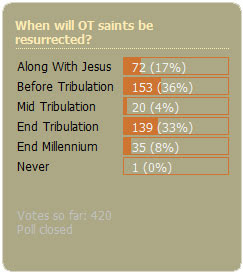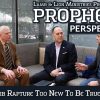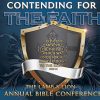The question of when will the Old Testament Saints be resurrected was put to the reader in March’s poll titled “When Will the OT Saints Be Resurrected?” The 420 respondents cast their vote among a number of categories. The result showed a wide range of opinions as to when they thought this resurrection would occur along God’s prophetic timeline. The results are as follows:

Multiple Resurrections
Dr. David Reagan in his article “Resurrections and Judgments” explains that the Bible reveals there will be more than one resurrection.
Jesus clearly taught that there would be more than one resurrection. In John 5:29 He refers to a “resurrection of life” and a “resurrection of judgment.” The apostle Paul confirmed this concept in his defense before Felix when he stated that he believed the teaching of the prophets “that there shall certainly be a resurrection of both the righteous and the wicked” (Acts 24:15).
Of course, it could be argued that the two resurrections referred to in these scriptures will occur at the same time. Thus, because they will happen simultaneously, there is, in effect, only one resurrection. However, the Scriptures establish the fact that the resurrection of the righteous will occur in stages.
In other words, the Bible does not teach one resurrection or even two resurrections in number. Rather, it teaches that there will be two resurrections in type which will be conducted in stages, resulting in several resurrections — at least four, to be specific — three for the just and one at the end of the Millennial Kingdom for the unjust.
The Resurrection of the Just
That the resurrection of the righteous will occur in stages is clearly taught in 1 Corinthians 15:20-24. In fact, the first stage of the resurrection of the righteous has already happened, for verse 20 says that “Christ has been raised from the dead, the first fruits of those who are asleep.”
Verses 22 and 23 go on to explain that all who have died in Christ shall be made alive, “but each in his own order: Christ, the first fruits, after that those who are Christ’s at His coming.”The imagery of the harvest that is used in these verses is a key to understanding the first resurrection — the resurrection of the righteous.
The Harvest Imagery
In Bible times the harvest was conducted in three stages. It began with the gathering of the first fruits which were offered as a sacrifice of thanksgiving to God.
It proceeded with the general harvest. But not all was taken in this harvest. Some of the crop was left in the field to be gathered by the poor and the needy. This was called the gleanings (Leviticus 19:9-10).
Using this imagery, the Bible presents the resurrection of Jesus as the “first fruits” of the resurrection of the righteous. The gathering of the Church Age saints, living and dead, at the appearing of the Lord (the Rapture) is thus the general harvest stage of the resurrection of the righteous (John 14:1-3 and 1 Thessalonians 4:13-18).
But there is a third and final stage to this resurrection of the righteous. It is the gleanings, and it occurs at the end of the Tribulation when the Lord’s Second Coming takes place. At that time two final groups of the righteous will be resurrected: 1) the Tribulation martyrs (Revelation 20:4), and 2) the Old Testament saints (Dan 12:2).
Some people are startled by the thought that the Old Testament saints will not be resurrected until the end of the Tribulation. But keep in mind that the Rapture is a promise to the Church, and the Church only. Also, the book of Daniel makes it clear that the Old Testament saints will be resurrected at the end of the “time of distress” (Daniel 12:1-2).
So the first resurrection, the resurrection of the righteous, occurs in three stages, beginning with Christ, continuing with the Church at the Rapture, and culminating with the Tribulation martyrs and the Old Testament saints at the return of Jesus.







My view is that Old Testament saints are part of the Church. They looked forward to the promise of Messiah. New Testament saints look back to the promise of Messiah. From what I can see Scripture makes it pretty clear that the two have become One Body through Christ Jesus.
Eph 3:1-6 states in no uncertain terms that through the Gospel the Gentiles are heirs together with Israel, members together of ONE body, and sharers together in the promise in Christ Jesus: Ephesians 3:1-6, “For this reason I, Paul, the prisoner of Christ Jesus for the sake of you Gentiles — Surely you have heard about the administration of God’s grace that was given to me for you, that is, the mystery made known to me by revelation, as I have already written briefly. In reading this, then, you will be able to understand my insight into the mystery of Christ, which was not made known to men in other generations as it has now been revealed by the Spirit to God’s holy apostles and prophets. This mystery is that through the Gospel the Gentiles are heirs together with Israel, members together of one body, and sharers together in the promise in Christ Jesus“
Romans 11:25-26 reveals to us that Israel is saved once the fullness of the Gentiles comes in. Romans 11:25-26, “For I would not, brethren, that ye should be ignorant of this mystery, lest ye should be wise in your own conceits; that blindness in part is happened to Israel, until the fulness of the Gentiles be come in. And so all Israel shall be saved: as it is written, There shall come out of Sion the Deliverer, and shall turn away ungodliness from Jacob”
1 Corinthians 12:12-13 says, “The body is a unit, though it is made up of many parts; and though all its parts are many, they form one body. So it is with Christ. For we were all baptized by one Spirit into one body — whether Jews or Greeks, slave or free–and we were all given the one Spirit to drink”
Ephesians 2:11-22, “Therefore, remember that formerly you who are Gentiles by birth and called ‘uncircumcised’ by those who call themselves ‘the circumcision’ (that done in the body by the hands of men)– remember that at that time you were separate from Christ, excluded from citizenship in Israel and foreigners to the covenants of the promise, without hope and without God in the world. But now in Christ Jesus you who once were far away have been brought near through the blood of Christ. For he himself is our peace, who has made the two one and has destroyed the barrier, the dividing wall of hostility, by abolishing in his flesh the law with its commandments and regulations. His purpose was to create in himself one new man out of the two, thus making peace, and in this one body to reconcile both of them to God through the cross, by which he put to death their hostility. He came and preached peace to you who were far away and peace to those who were near. For through him we both have access to the Father by one Spirit. Consequently, you are no longer foreigners and aliens, but fellow citizens with God’s people and members of God’s household, built on the foundation of the apostles and prophets, with Christ Jesus himself as the chief cornerstone. In him the whole building is joined together and rises to become a holy temple in the Lord. And in him you too are being built together to become a dwelling in which God lives by his Spirit.”
Notice the following: Jesus referenced the church in the book of Matthew both directly and indirectly. Notice what Christ said here about resolving conflicts in the church.
Matthew 18:15-18, “If your brother sins against you, go and show him his fault, just between the two of you. If he listens to you, you have won your brother over. But if he will not listen, take one or two others along, so that ‘every matter may be established by the testimony of two or three witnesses.’ If he refuses to listen to them, tell it to the church; and if he refuses to listen even to the church, treat him as you would a pagan or a tax collector. I tell you the truth, whatever you bind on earth will be bound in heaven, and whatever you loose on earth will be loosed in heaven.”
Remember, Jesus was addressing this teaching to a Jewish audience and is calling them the church. Since the Church (as it is taught by modern dispensationalism) was not yet formed, then what was Christ referring to? We find another clue in the book of Acts:
Acts 7:37-38, “This is that Moses, which said unto the children of Israel, A prophet shall the Lord your God raise up unto you of your brethren, like unto me; him shall ye hear. This is he, that was in the church in the wilderness with the angel which spake to him in the mount Sina, and [with] our fathers: who received the lively oracles to give unto us”
Thus, the Church is in fact the assembly of believers — true Israel — comprised of both the Old Testament believers who looked forward to the promise of Messiah who was to come, as well as the New Testament believers who look back to the promise of Messiah who came. The Church is One Body, and it is those who have a relationship with YHWH the God of Abraham, Isaac and Jacob.
ChristianAnswers.net makes a few points by noting that, “God has ever had only one church on earth. We sometimes speak of the Old Testament Church and of the New Testament church, but they are one and the same. The Old Testament church was not to be changed but enlarged (Isa. 49:13-23; 60:1-14). When the Jews are at length restored, they will not enter a new church, but will be grafted again into “their own olive tree” (Rom. 11:18-24; compare Eph. 2:11-22). The apostles did not set up a new organization. Under their ministry disciples were ‘added’ to the ‘church’ already existing (Acts 2:47).”
In Matthew 16:18 Jesus said that He would build His church “upon this rock”. But who is the rock? Peter or Christ? Scripture gives us the answer.
1 Cor. 3:11, “For other foundation can no man lay than that is laid, which is Jesus Christ.“
1 Cor 10:1-4, “Moreover, brethren, I would not that ye should be ignorant, how that all our fathers were under the cloud, and all passed through the sea; And were all baptized unto Moses in the cloud and in the sea; And did all eat the same spiritual meat; And did all drink the same spiritual drink: for they drank of that spiritual Rock that followed them: and that Rock was Christ.“
Christ said that He would build His Church. Not create it from anew, but build it (the Greek word is oikodomeō) — the Church already existed for the foundation had already been laid, and now because of Christ Jesus, Gentiles would be added to His Church and would no longer be foreigners and aliens, but fellow citizens with God’s people and members of God’s household, built on the foundation of the apostles and prophets, with Christ Jesus himself as the chief cornerstone. (Eph. 2:11-22).
Bob Pickle of Pickle Publishing makes a few noteworthy points by writing that, “Ekklesia, the Greek word translated ‘church’ in the New Testament, is often used to refer to Israel in the ancient Greek version of the Old Testament known as the Septuagint (LXX). In the LXX ekklesia is even used as a synonym for the Greek word sunagoge, a word that we transliterate as ‘synagogue.’ Further, sunagoge in the LXX sometimes refers to Gentiles. These facts indicate that in Scripture there is not as sharp a distinction between the church and Israel as modern dispensationalism would have us believe.
Many dispensationalists have said, ‘Israel is not the Church and the Church is not Israel.’ A lot of doctrines and eschatology are built upon this premise. Yet when one examines Scripture itself, one is surprised to discover that Israel in the Old Testament is repeatedly called the ‘church.'”
There is only one plan of salvation for man, and that has always been and will always be through Messiah Yeshua, and Him alone, for there is no other Name given under Heaven where we can be saved. One Tree, One Body, One Church, One Bride, One Savior, One God. That’s how I see it. 🙂
Great article Nathan!!
Perhaps those who came out of their tombs to appear in Jerusalem following the Lord’s resurrection were fulfilling of the “wave offering” required in the feast of first fruits wherein a sample of the harvest is brought into the temple to be waved over the altar so the whole harvest can be accepted. (Lev. 23:9-11)
I would like to think and believe that the old testament believers are in Heaven right now. I want to believe that the prophets of the Old Testament along with the disciples, and the God-fearing men and women are in the present Heaven. Didn’t Jesus, while dying on the cross, tell the thief on the cross that He “will see him Paradise”. On a lighter note, I think those believers who are now in Heaven are have a great time visiting with Moses, Abraham, Elijah, Mary, etc, etc.
RS
Very “Covenant Theology” of you, Mitchell. I left supporting Covenant Theology because of it’s view that salvation before Christ hinged on looking forward to the Messiah. CT just doesn’t cover pre-Abrahamic times… not enough info for folks to know about a Messiah.
Salvation is always about faith in God and Jesus’ saving work. That’s why those OT in Paradise couldn’t go to Heaven until Jesus’ work was completed.
I will be pondering Matt. 18’s reference to “church,” though… interesting.
Question: What is “Covenant Theology”?
In my own words, Covenant Theology is the theological position that Jesus’ First Coming is the focal time in all of human history. Everyone since creation who looked towards a Messiah were saved, and after Jesus’ resurrection everyone since looks back.
Amillennialists who love to spiritualize scriptures and Post-Millennialists who see the Church ushering in God’s kingdom are big on this view, because the Church in this view is the be-all and end-all of man’s history.
Even as a kid I found Covenant Theology greatly lacking because the concept of OT folks waiting for a Messiah as a requirement for salvation unbiblical and not very clear in OT writings, especially before Abraham. It also diminishes Jesus’ Second Coming, Millennial Kingdom, and the eternal state which is truly God’s victory and sovereignty.
Dispensationalism, the view that God reveals Himself more over time until mankind (a saved remnant) is finally reunited with God just like Pre-Fall for me explains so much more about God’s plan for the ages.
I think gotquestions.org does a pretty good job of explaining things.
http://www.gotquestions.org/covenant-theology.html
Roger
Not to diminish your fine explanation though Nathan 🙂
Thank you. I had heard that before, I just didn’t know what it was called.
Nathan Jones writes, “Very “Covenant Theology” of you, Mitchell.” —
I do not adhere to “Covenant Theology” at all, even though some points you noted above may seem to be be similar. My view is much closer to Progressive Dispensationalism, since it is soundly supported from Scripture as a whole in my opinion. Modern Dispensationalism (sometimes called Classical Dispensationalism) as systematized by John Nelson Darby is what my own studies have caused me to question and, consequently, move away from.
http://www.endtimes.org/progressive_dispensationalism.html
http://www.theologicalstudies.org/dispen.html
Very interesting… Progressive Dispensationalism. What about before the Patriarchs? There’s almost 2000 years of history before God made promises to Abraham.
That would have to be the Adamic dispensation (until Abraham).
http://worldview_3.tripod.com/dispensation.html
mitchell and nathan, i enjoy watching your discussions on the blog. not kidding. covanant theology tho i’m not in total agreement does make some valid points. people before the flood, in the old testament, the church age, the tribulation and milleneum are ALL saved by christs’ work on the cross. the o.t. saints were “atoned” (to cover) by sacrifice pointing to jesus. it sounds like that is what covanant theology is saying. could be mistaken tho. may have misunderstood what was said.
I would agree hartdawg that Covenant Theology does make some valid points, but as a whole it is inherently flawed. Progressive Dispensationalism, on the other hand, offers sound Scriptural answers to the problems not only with Covenant Theology but also the problems with Classic / Traditional Dispensationalism that many churches have been taught and still teach today.
Here is another good explanation of Progressive Dispensationalism.
PD 101: http://www.pfrs.org/pd/001.html
PD 102: http://www.pfrs.org/pd/002.html
A fascinating subject that everybody should find the time to study imo.
God bless y’all…
On the subject of Dispensationalism in its various forms (Classic, Progressive and Ultra), Covenant Theology, Amillennialism etc, I highly recommend Ryrie’s updated Dispensationalism. Ryrie also addresses a lot of the allegations levelled at this system – Salvation etc.
While Darby is rightly credited as one of the main driving forces in promoting Dispensationalism, there were rudimentary concepts of it that predated him going back as far as Justin Martyr. What Classic or Normative Dispensationalim is now is not exactly what Darby systemized. Scofield’s scheme more closely resembled Isaac Watt’s, according to Ryrie.
And I would encourage readers of Ryrie’s work to not stop there, study the PD view as well to hear both sides. That way you’re better equipped to come to an informed decision on the subject:
The Case for Progressive Dispensationalism by Robert L. Saucy could be a good start:
http://www.amazon.com/Case-Progressive-Dispensationalism-Robert-Saucy/dp/0310304415
Progressive Dispensationalism by Craig A. Blaising is another:
http://www.amazon.com/Progressive-Dispensationalism-Craig-Blaising/dp/0801022436
The links above include reviews that others have left regarding the books.
I also have John Macarthur’s “The Gospel According To Jesus”. I admire MacArthur and enjoy his books. However, in it he makes some comments about Dispensationalism which Ryrie carefully corrects, which is just one reason why his book is a must read IMO. When I wanted to buy a book of Systematic Theology I was warned to not get one by a Dispensationalist for various reasons – none of which I now find legitimate. It’s a complicated subject that is often obfuscated by emotion and inaccurate statements about Dispensationalism.
http://tinyurl.com/ceqtg6
http://tinyurl.com/cdzmas
Thanks for the links anon. My only comment would be that George Zeller’s critique of the progressive position creates a strawman argument by, for example, incorrectly implying that PD only teaches that “the Davidic kingdom is operational today”. But as Tim Warner points out, some progressive dispensationalists believe the Davidic Covenant is only “partially fulfilled during this dispensation, with Christ seated on David’s throne at the right hand of the Father. This in no way diminishes His future reigning in the Millennium. However, this is NOT a crucial issue within progressive dispensationalism. Other progressive dispensationalists, including this author, agree with traditional dispensationalists that this covenant will only be inaugurated upon the second coming.”
Moreoever, Zellar assumes that there are “essential doctrines of dispensationalism” such as the parenthetical nature of the church, when I would argue that it can be forcefully demonstrated from Scripture that this is not the case whatsoever and is, in fact, hermeneutically unsound. From the traditional dispensational position that is his view, but not for dispensationalism itself. As Warner’s article points out, the fact that God continues to deal with Israel in this dispensation is a problem for traditional dispensationalism, which the progressive view answers:
“Certain things have and are occurring in Israel’s history since the Day of Pentecost that are the direct fulfillment of prophecy. This makes the traditional dispensational ‘parenthetical’ theory untenable.
a. The destruction of Jerusalem in AD 70 was the direct fulfillment of Daniel 9:26.
b. The regathering of Israel into their land is the likely fulfillment of Ezekiel 37.
c. God is also using the salvation of the Gentiles to provoke (unbelieving) Israel to jealousy. [Rom. 10:18,19 & 11:11]."
Good meaty topic. Chew slowly friends and don't forget the spiritual drink! 🙂
“Certain things have and are occurring in Israel’s history since the Day of Pentecost that are the direct fulfillment of prophecy. This makes the traditional dispensational ‘parenthetical’ theory untenable.”
I see where you are coming from. While certain things have by necessity occurred to Israel prior to and beyond what transpired during the 69 weeks, IMO, calling the parenthetical theory untenable is premature (Dan 9:24-27). Perhaps it boils down to what God is primarily focussing on within a given period and whether it can be show that He deals with two distinct programs simultaneously. Ryrie also addresses the Davidic Covenant and parenthetical issues. While God is not primarily dealing with Israel now and it’s not the seventieth week, He still needs to have the pieces in play when that period begins. However, I do agree that it’s a “meaty topic” containing much to chew on. Let everyone study and prove for themselves.
anon says, “However, I do agree that it’s a “meaty topic” containing much to chew on. Let everyone study and prove for themselves.” –
I concur. 🙂
Anyone who claims that their view is closer to Prog Disp and distances themselves from Classic Disp and yet believes in some vague OT/NT continuity of Israel via the church, hasn't really grasped PD at all.
Saucy (and Bock for that matter, is far closer to classic disp than many self-described lay PDs (e.g. Mitchell above & Tim Warner).